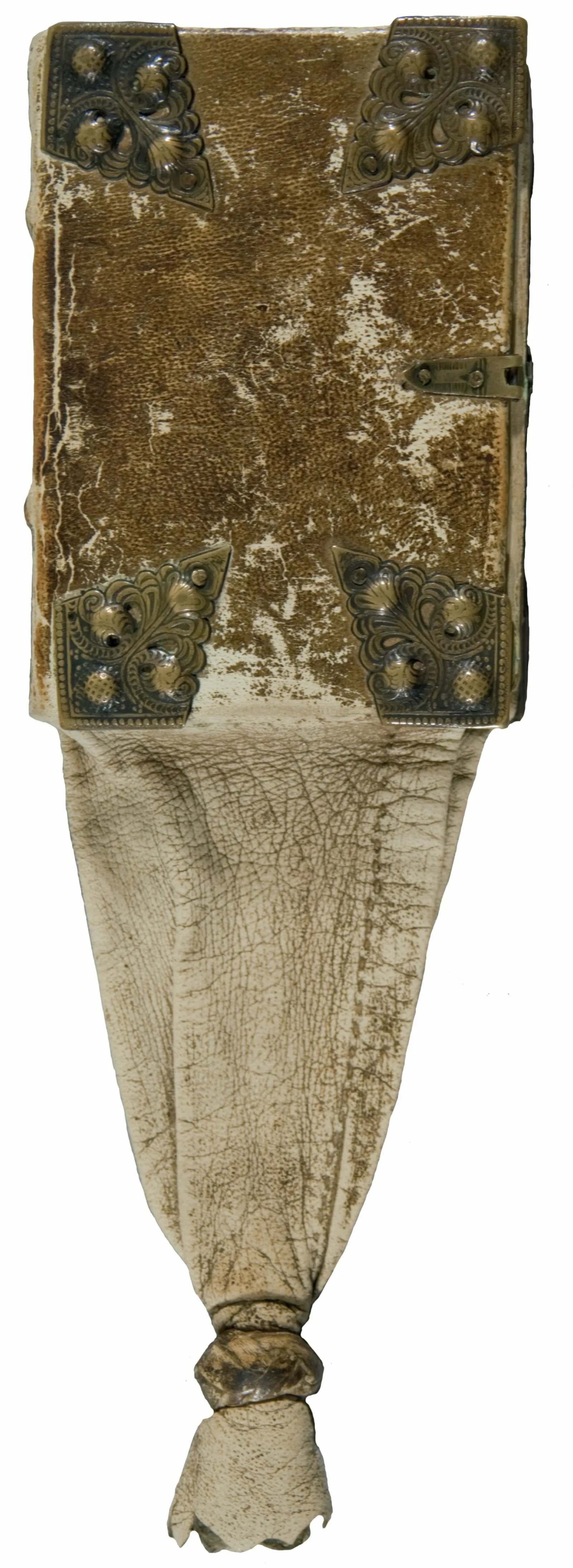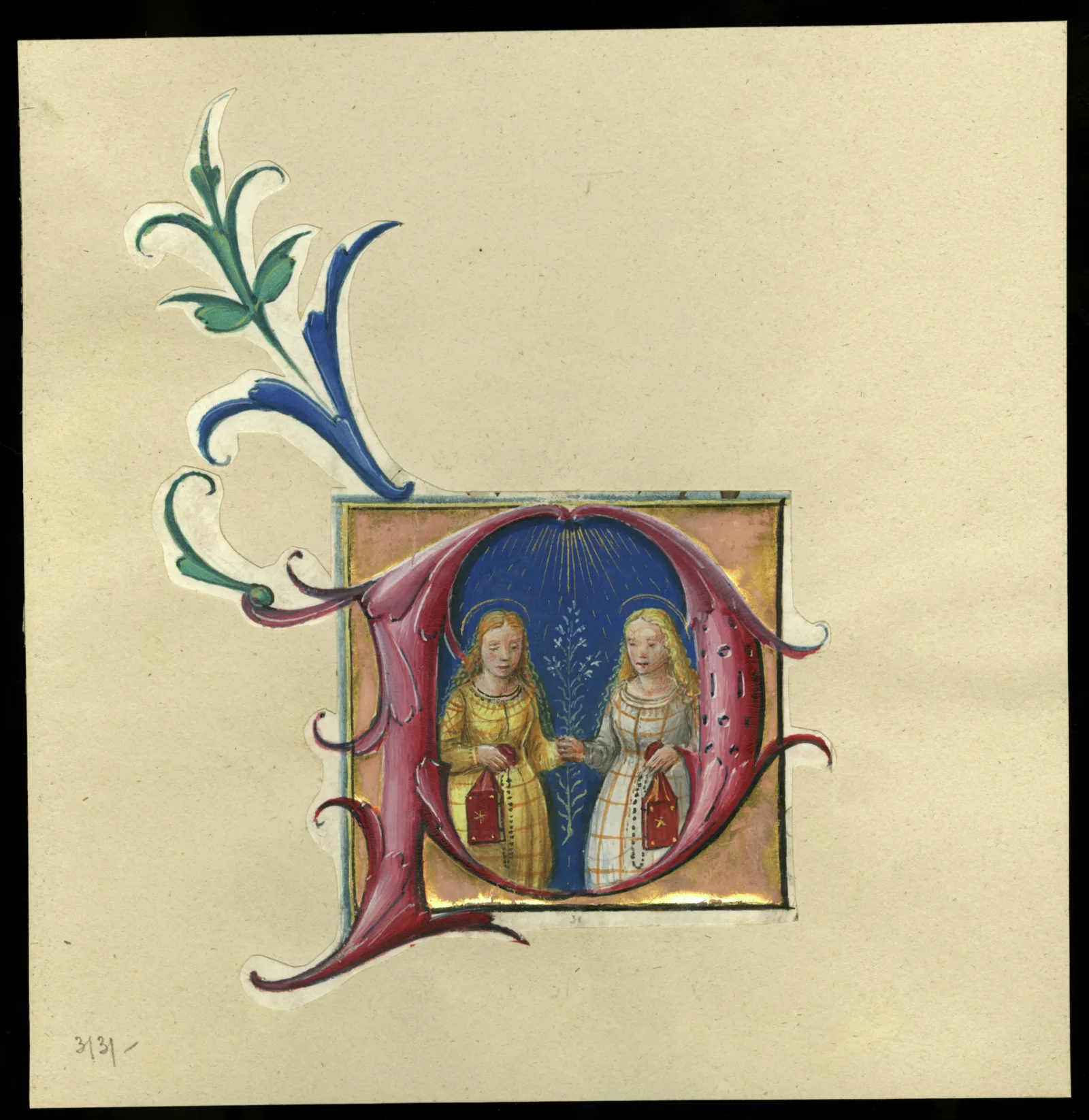Nestled in the open circle of a decorative capital P, two devout young women hold rosaries, girdle books, and a lily. The meticulously crafted letter, an ornament cut from a northern Italian choir book, is by a miniaturist well versed in contemporary culture, fashion, and arts at the turn of the 16th century.
The graphic contours and exquisitely delicate lines that describe the volumetric forms, sun-kissed ringlets, and divine rays from the Holy Spirit reflect the miniaturist’s familiarity with engraving. The proposal that the initial P may have been painted by the Master B.F., a follower of Leonardo da Vinci, is a recent conjecture.
For decades, the creator was unknown, but now more evidence has come to light to justify the attribution. The artist’s deft touch with a fine-tipped brush, rich color palette, and twin figures certainly call to mind the work of Master B.F., although instead of depicting standard religious subjects such as saints, martyrs, and biblical scenes, here he illustrates the outward expression of the extraordinary inner spirit and piety of two ordinary girls.
The simple cut of their dresses—smooth-fitted bodice, long sleeves, and bell-shaped skirt with minimal pleats emphasizing a narrow waist—is an up-to-date design, as draped clothing with softer lines was falling out of fashion. Only one kind of fabric was used for each dress, and both share a matching geometric pattern. The delicate trim around the scoop neck is the only adornment; jewelry may have been too costly or extravagant to wear to prayer.
The adolescents’ faces are framed by long, amber and flaxen curling hair, imbuing them with an angelic glow, echoed by thin halos. Blond hair, associated with youth and beauty, was in vogue at the time in northern Italy. Those not born with golden locks could lighten their hair by dying it with a concoction such as pulverized cabbage and boxwood shavings, or by bleaching it in the sun to create a more natural and fashionable look.
Girdle books were also popular throughout Europe around this time. Named because they could be worn at the waist, the books were made with long leather covers that extended beyond the lower edge of the book board. The girdle book could hang upside down from a belt, secured by a knot or hook, or as seen here, be gripped like a cinched bag ready to be turned upright and read.

Prayers, psalms, and other works for daily devotions were the most common texts included in girdle books. Through frequent use and exposure to the elements, the leather covers easily wore out, or sometimes the extension was cut off so the book would more easily fit on a shelf. Only 26 girdle books survive—one of which is at the Newberry.
With their modest attire, books, and prayer beads, the fair-skinned young women represent educated, pious members of the merchant or professional class. They may be part of a female rosary confraternity, a private prayer group that became popular in late 15th-century Italy among women who had been excluded from participating in religious assemblies organized by all-male societies. Some men believed that if women gathered together, they would gossip incessantly. But for these girls, the only whispers uttered would be in solemn praise to the Virgin Mary, represented by the white lily.
The mirrored composition, execution, and colors of the Newberry’s historiated letter are similar to those of other works by the Master B.F., who is named after the monogram that appears in several of his illuminations.
Master B.F. often used double figures in his letters. The pose of the young women in the Newberry fragment is most similar to that of twin martyrs in a historiated initial T that decorates Folio 138 recto in the 1510 manuscript of liturgical chants written for the monastery of Sant’Ambrogio ad Nemus in Milan. Other double figures include Saints Apollonia and Catherine of Alexandria (Gilli Collection, Milan) and Saints Peter and Paul (British Library, London).
The shape of the Newberry’s letter P, accented with acanthus leaves and set in a gold square, matches the letter P included in a 2015 Christie’s sale of 12 historiated initials by Master B.F. The initial P from the Christie’s sale features the Eucharist on a royal blue background with fine gold lines radiating from its center, paralleling the symmetrical composition and gold rays in the Newberry fragment. The average size of the 12 letters from the Christie’s sale is 75 x 78 mm; the size of the square of the Newberry’s letter is 75 x 77 mm. It’s not unreasonable to conclude that the Newberry’s letter was cut from the same choir book as the Christie’s letters.
Although there is some debate about the true identity of Master B.F., many scholars have suggested he could be the engraver and miniaturist Francesco Binasco (active in Milan about 1486 to 1520), who was court illuminator and goldsmith for Francesco Sforza, the last sovereign Duke of Milan. Both Master B.F. and Binasco worked in the style of Leonardo. Master B.F. exhibits a sound knowledge of engraving—not only through his use of linework, but also in his appropriation of the group of buildings from Albrecht Dürer’s engraving The Prodigal Son (ca. 1496) for the illumination The Adoration of the Magi, now in the Morgan Library’s collection.
If the attribution to Master B.F. is correct, then the Newberry’s historiated initial P was cut from one of the 20 antiphonals he illuminated for the Olivetan monastery Santi Angelo e Niccolò in Villanova Sillaro, a commune about 22 miles outside of Milan, in the province Lodi. The monastic complex was consecrated by Bishop Carlo Pallavicino on April 29, 1496, after which Master B.F. was commissioned to decorate the choir books, from about 1500 to 1510.
In 1796, French troops under Napoléon Bonaparte attacked and looted monasteries throughout Lodi, including Santi Angelo e Niccolò, which closed two years later. Manuscripts illuminated by Master B.F. were cut apart and the fragments dispersed, their locations unknown until they began to appear at auction in the early 19th century.
Today, the historiated initial P with two modern and devoted young women is a jewel at the Newberry. The scintillating illumination is fortunate to have kept good company with one of the few remaining girdle books, as well as many other early Renaissance treasures.
About the Author
Debora Wood is an Independent Curator and Newberry Reader.
